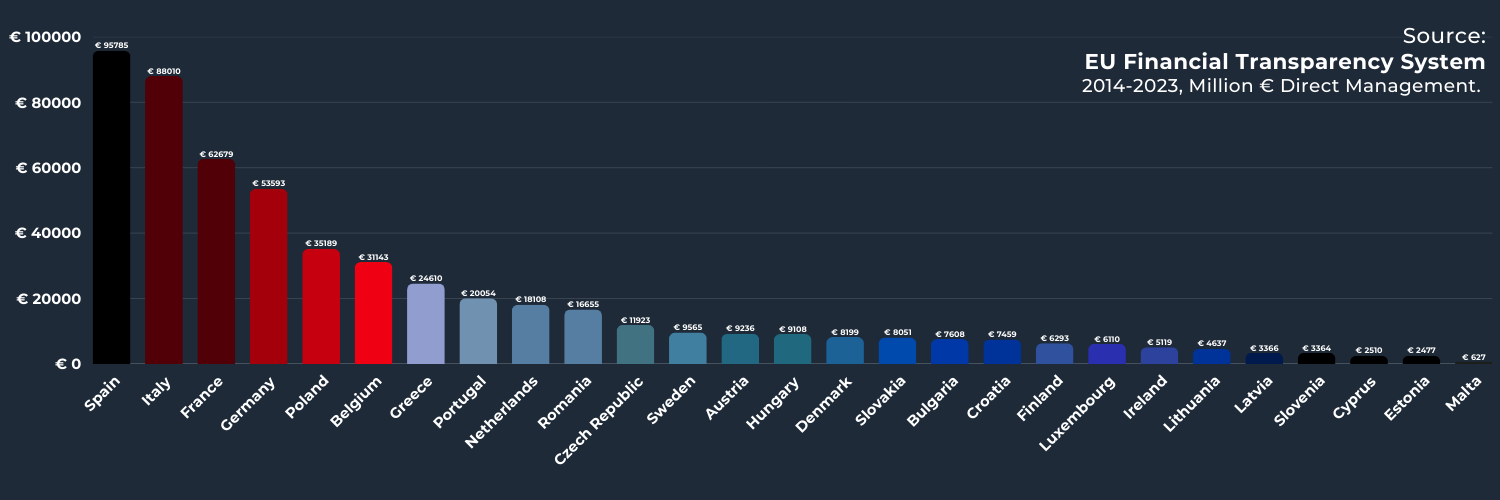But what do these categories mean, and why do some countries spend billions on government-led projects while others funnel funds into businesses and non-profits?
What do Member States and Public Bodies represent?
Understanding EU funding begins with distinguishing between member states and public bodies.
Member states: this category refers to national governments managing large-scale EU-funded projects. These funds often support infrastructure development (e.g., highways, railways), energy transitions, or national-level programs like education reforms. Member state funding is typically centralized and managed by ministries or other national authorities.
Public bodies: these are local or regional authorities such as city councils, universities, or municipal agencies. Public bodies receive funding for community-level initiatives like urban development, research programs, or public health campaigns. Unlike member states, public bodies operate closer to citizens and focus on localized impact.
While both categories serve the public sector, member states handle macro-level projects while public bodies address micro-level needs.
The allocation of funds reveals stark differences in priorities between countries.
This article includes two interactive tools to help you explore how EU funds were allocated across member states, public bodies, private companies, and NGOs. Hover over any bar to see exact amounts for each category, to see the expenditure (Million €) for each country.
Priorities across Europe
Spain’s public sector focus (€95.8 billion total)
Spain allocated €80.8 billion to member states — 84% of its total funding — making it the EU’s undisputed leader in centralized spending. Public bodies received €5.04 billion (5.3% of total), while NGOs and private companies shared €5.77 billion and €4.04 billion respectively. This imbalance highlights a system favoring national ministries over local authorities or civil society, despite Spain’s persistent 12% unemployment rate and crumbling rural infrastructure.
Key irony: Spain’s member state funding (€80.8B) exceeds the combined NGO budgets of Germany, France, and Italy.
Belgium’s private sector emphasis (€31.0 billion total)
Belgium’s unique funding profile stands out starkly in the EU, with €13.3 billion allocated to private companies — 43% of its total direct management funds from 2014 to 2023. This is by far the largest proportion directed to the private sector among member states, dwarfing allocations by much larger countries such as Germany (€3.49 billion), France (€4.63 billion), Spain (€4.04 billion), and Italy (€4.57 billion). With a mean population of just 11.5 million, Belgium spent €1,156 per person on private companies — more than ten times the per capita amounts of Spain (€86), Italy (€76), and Germany (€43).
This heavy investment in the private sector is matched by €7.87 billion allocated to NGOs and NFPOs, making Belgium a hub for EU-funded nonprofit activity. However, this dual emphasis on private companies and NGOs raises serious concerns about transparency, particularly given Belgium’s lack of a dedicated anti-fraud office to oversee these funds.
Romania’s heavy reliance on member states (€16.7 billion total)
Romania funneled €14.0 billion to member states (84% of total), leaving crumbs for public bodies (€0.46 billion) and NGOs (€0.34 billion). This mirrors Eastern Europe’s broader trend of centralizing funds — often at the expense of local governance and anti-corruption watchdogs.
Key irony: Romania’s member state allocation could build 23,300 km of rural roads — yet its road quality ranks EU’s 3rd worst (World Economic Forum).
France’s balanced approach (€62.7 billion total)
France distributed funds more evenly: €42.6 billion to member states (68%), €7.56 billion to public bodies (12%), €7.29 billion to NGOs (11.6%), and €4.63 billion to private companies (7.4%). This reflects a dual focus on national infrastructure (e.g., high-speed rail) and local initiatives (e.g., university research grants).
Key irony: despite France’s “green transition” pledges, €42.6 billion for member states includes subsidies for fossil fuel-linked industries.
Sources: EU Financial Transparency System (2014-2023), World Bank Development Indicators.
All figures derived from the user-provided table, cross-checked with EU audit reports.
Why these priorities matter
The way EU funds are allocated reflects each country’s governance style and economic goals:
Countries prioritizing member states (e.g., Spain, Romania) tend to focus on large-scale infrastructure projects but risk neglecting local needs and innovation-driven growth.
Countries investing heavily in private companies (e.g., Belgium) emphasize entrepreneurship and research but may overlook broader societal benefits tied to public sector development.
These discrepancies underscore the need for balanced spending that empowers both national governments and local authorities while ensuring grassroots organizations have the resources they need to thrive.
Conclusion: transparency is key
EU funding is meant to empower citizens by supporting projects that drive progress at every level — from national infrastructure to community-led initiatives. But the numbers reveal imbalances that demand scrutiny: are member state allocations addressing real needs? Are public bodies receiving enough support? And why are NGOs consistently underfunded despite their direct impact on communities?
Click on each country’s button to see directly the priorities of each EU member.




